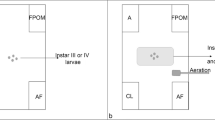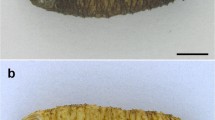Abstract
Mealworm beetles have been used in numerous experiments as bioindicators. The aim of our experiment was to study the elemental composition in three larvae, pupae and first and second generation adult stages during their life cycle. We selected 180 larvae from a genetically similar population and put them in three groups, in two boxes (60 larvae in each box). Larvae were fed with mashed potato made of the same quality and quantity of potato powder. Then, we selected 10 individuals from each stage to the elemental analysis, using the ICP-OES method. The following elements were analysed in the studied stages: Ca, Cu, Fe, K, Mg, Mn, Na, P, S, Sr and Zn. The results of principal component analysis demonstrated that based on elemental composition, different stages were separated with each other, but in the cases of the three larvae stages, high overlap was found. The results of the GLM ANOVA showed significant differences between the different stages of metamorphosis-based elemental composition. Our results show that the calcium and magnesium were found in a relatively high concentration, while the iron and zinc may be essential elements during the metamorphosis. Our results also show that in insect, the concentration of sodium was higher than in the pupa which may cause by hemolymph. We also demonstrated that the metamorphosis has an effect on the concentration of elements. Our study shows that in the different stages of insects, there are significant changes in the elemental composition of different stages of insects during their metamorphosis.



Similar content being viewed by others
References
Andersen AN, Hoffmann BD, Müller WJ, Griffiths AD (2002) Using ants as bioindicators in land management: simplifying assessment of ant community responses. J Appl Ecol 39:8–17
Lindqvist L, Block M (1997) Losses of Cd, Hg, and Zn during metamorphosis in the beetle Tenebrio molitor (Coleoptera: Tenebrionidae). B Environ Contam Tox 58:67–70
Rocha JRM, Almeida JR, Linus GA, Durval A (2010) Insects as indicators of environmental changing and pollution: a review of appropriate species and their monitoring. HOLOS Environment 10:250–262
Costantino RF, Desharnais RA, Cushing JM, Dennis B (1997) Chaotic dynamics in an insect population. Science 275:389–391
Castilla AM, Dauwe T, Mora I, Malone J, Guitart R (2010) Nitrates and herbicides cause higher mortality than the traditional organic fertilizers on the Grain Beetle, Tenebrio molitor. B Environ Contam Tox 84:101–105
Frankel G (1951) Effect and distribution of vitamin BT. Arch Biochem Biophys 34:457–467
Pedersen SA, Kristiansen E, Andersen RA, Zachariassen KE (2008) Cadmium is deposited in the gut content of larvae of the beetle Tenebrio molitor and involves a Cd-binding protein of the low cysteine type. Comp Biochem Physiol Part C 148:217–222
Pedersen SA, Kristiansen E, Hansen BH, Andersen RA, Zachariassen KE (2006) Cold hardiness in relation to trace metal stress in the freeze-avoiding beetle Tenebrio molitor. J Insect Physiol 52:846–853
Sheiman IM, Shkutin MF, Terenina NB, Gustafsson MK (2006) A behavioral study of the beetle Tenebrio molitor infected with cysticercoids of the rat tapeworm Hymenolepis diminuta. Naturwissenschaften 93:305–308
Sheiman IM, Shkutin MF (2003) Effect of weak electromagnetic radiation on learning in the grain beetle Tenebrio monitor. Zh Vyssh Nerv Deiat Im I P Pavlova, Russian 53:775–780
Morales-Ramos JA, Rojas MG, Shapiro-Ilan DI, Tedders WL (2009) Developmental plasticity in Tenebrio molitor (Coleoptera: Tenebrionidae): analysis of instar variation in number and development time under different diets. J Entomol Sci 45:75–90
Ludvig D, Fiore C (1960) Further studies on the relationship between parental age and the life cycle of the mealworm, Tenebrio molitor. Ann Entomol Soc Am 53:595–600
Delbecque JP, Hirn M, Delachambre J, De Reggi M (1978) Cuticular cycle and molting hormone levels during the metamorphosis of Tenebrio molitor (Insecta Coleoptera). Dev Biol 64:11–30
Butler JE, Leone CA (1966) Antigenic changes during the life cycle of the beetle, Tenebrio molitor. Comp Biochem Physiol 19:699–711
Wegerhoff R, Breidback O (1992) Structure and development of the larval central complex in a holometabolous insect, the beetle Tenebrio molitor. Cell Tissue Res 268:341–358
Wigglesworth VB (1948) The structure and deposition of the cuticle in the adult mealworm Tenebrio molitor L. (Coleoptera). Quart J Microsc Sci 89:197–217
Sonleitner FJ, Gutherie J (1991) Factors affecting oviposition rate in the mealworm beetle Tribolium castaneum and the origin of the population regulation mechanism. Res Popul Ecol 33:1–11
Klein M, Purcell AH (1987) Response of Galleria mellonella (Lepidoptera: Pyralidae) and Tenebrio molitor (Coleoptera: Tenebrionidae) to Spiroplasma citri inoculation. J Invertebr Pathol 50:9–15
Genta FA, Dillon RJ, Terra WR, Ferreira C (2006) Potential role for gut microbiota in cell wall digestion and glucoside detoxification in Tenebrio molitor larvae. J Insect Physiol 52:593–601
Eguchi M, Iwamoto A (1976) Alkaline proteases in the midgut tissue and digestive fluid on the silkworm, Bombyx mori. Insect Biochem 6:491–496
Birk Y, Harpaz I, Ishaaya I, Bondi A (1962) Studies ont he proteolytic activity of the beetles Tenebrio and Tribolium. J Insect Physiol 8:417–429
Jones CR (1964) Changes in the activity of respiratory enzymes in various organs during the metamorphosis of the mealworm, Tenebrio molitor Linnaeus. J Cell Compar Physl 63:65–69
Braun M, Simon E, Fábián I, Tóthmérész B (2009) The effects of ethylene glycol and ethanol on the body mass and elemental composition of insects collected with pitfall traps. Chemosphere 77:1447–1452
Braun M, Simon E, Fábián I, Tóthmérész B (2012) Elemental analysis of pitfall-trapped insect samples: effects of ethylene glycol grades. Entomol Exp Appl 143:89–94
Zar JH (1996) Biostatistical analysis. Prentice-Hall, Englewood Cliffs
McFarlane JE (1991) Dietary sodium, potassium and calcium requirements of the house cricket, Acheta domesticul (L.). Comp Biochem Physiol 100:217–220
Chapman RF (1998) The insects: structure and function. Cambridge University Press, Cambridge
Lang CA (1963) The accumulation of zinc by the mosquito. J Gen Physiol 46:617–627
Zhuang P, Zou H, Shu W (2009) Biotransfer of heavy metals along a soil-plant-insect-chicken food chain: field study. J Environ Sci 21:849–853
Nummelin M, Lodenius M, Tulisalo E, Hirvonen H, Alanko T (2007) Predatory insects as bioindicators of heavy metal pollution. Environ Pollut 145:339–347
Ernst WHO (1992) Nutritional aspects in the development of Bruchidius sahlbergi (Coleoptera: Bruchidae) in seeds of Acacia erioloba. J Insect Physiol 38:813–838
Acknowledgments
The work is supported by the TÁMOP 4.2.1./B-09/1/KONV-2010-0007 and TÁMOP-4.2.2.A-11/1/KONV project. These projects are implemented through the New Hungary Development Plan, co-financed by the European Social Fund and the European Regional Development Fund.
Conflict of interest
The authors declare no conflicts of interest.
Author information
Authors and Affiliations
Corresponding author
Rights and permissions
About this article
Cite this article
Simon, E., Baranyai, E., Braun, M. et al. Elemental Concentration in Mealworm Beetle (Tenebrio molitor L.) During Metamorphosis. Biol Trace Elem Res 154, 81–87 (2013). https://doi.org/10.1007/s12011-013-9700-1
Received:
Accepted:
Published:
Issue Date:
DOI: https://doi.org/10.1007/s12011-013-9700-1




